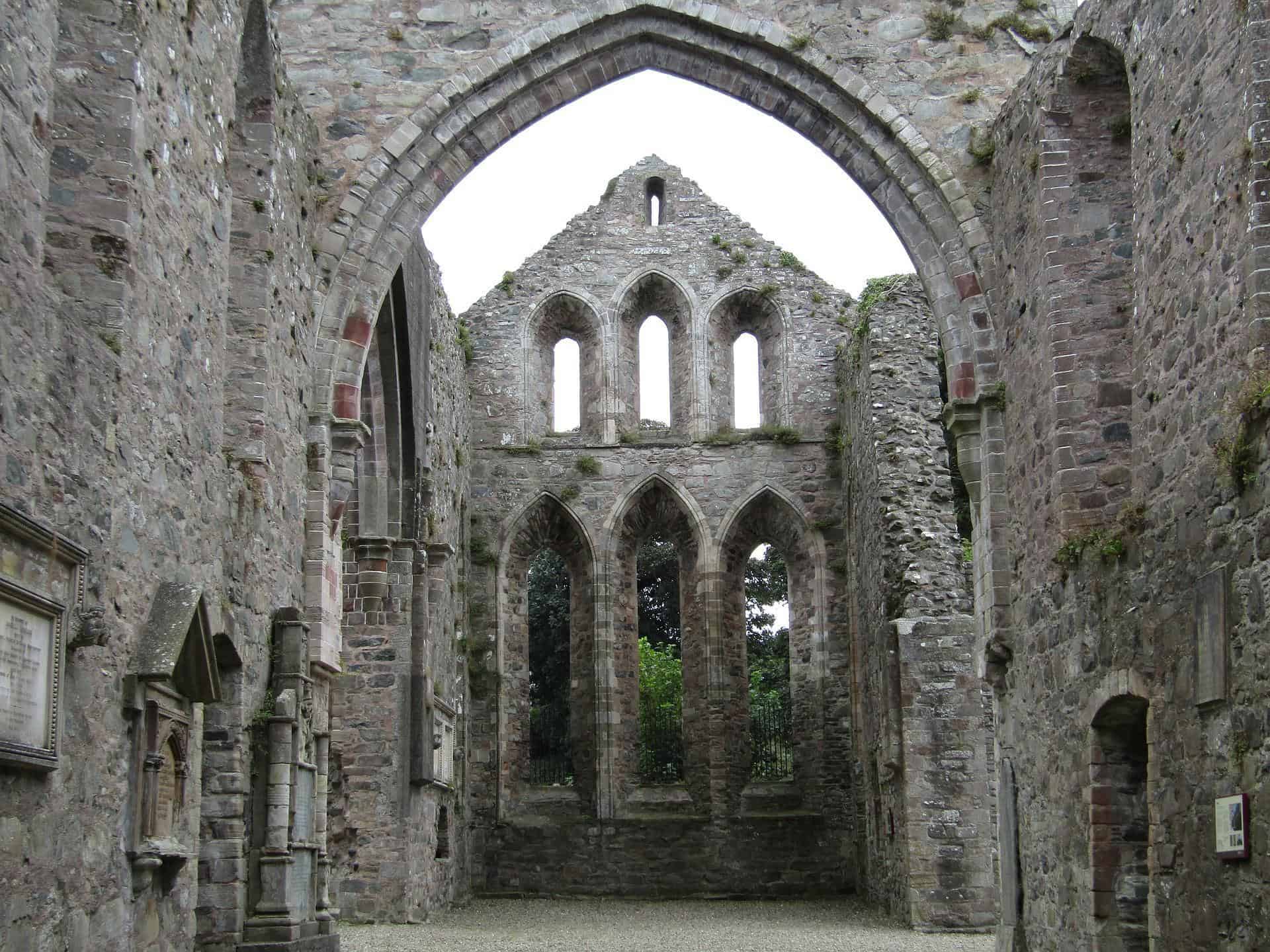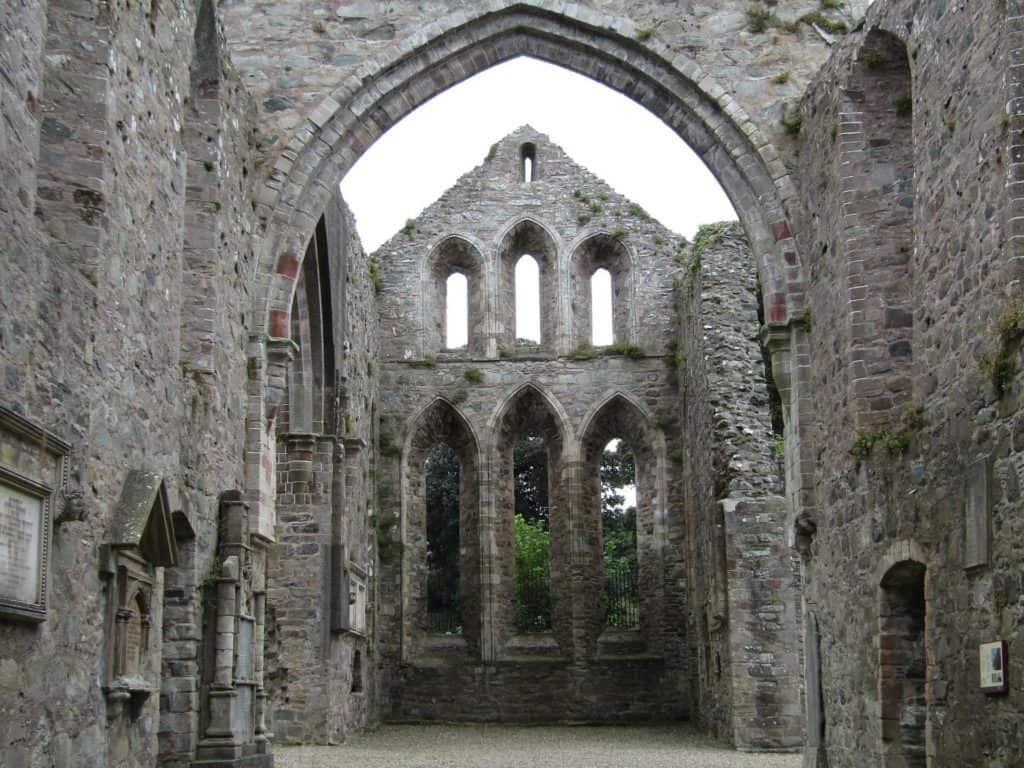More than 5 Facts about the Amazing GREYABBEY or GREY ABBEY in Newtownards, County Down

Updated On: April 08, 2024 by Ciaran Connolly
Nestled in the enchanting landscape of Newtownards in County Down, Northern Ireland, the historic site of Greyabbey, also known as Grey Abbey, stands as a testament to a rich and layered past. More than just the ruins of an ancient structure, Grey Abbey embodies a living narrative of history, a showcase of architectural mastery, and a serene retreat from the modern world. This abbey, a jewel in the crown of Northern Irish heritage, is not merely a static monument but a dynamic portal into a bygone era.
Located amidst the verdant parkland of the 18th Century Rosemount House, approximately ten miles from the vibrant city of Belfast, Grey Abbey is an accessible yet tranquil destination. Its proximity to the scenic beauty of Strangford Lough further enhances its appeal, providing visitors with a holistic experience that merges historical exploration with natural splendour. The abbey’s setting in this picturesque locale underscores its importance as a cultural and architectural landmark.
Grey Abbey’s story begins in the medieval period, reflecting centuries of religious, social, and architectural evolution. The remnants of this building are far more than crumbling walls; they are the chapters of a rich storybook that dates back hundreds of years. Each stone and archway speaks to the skilled craftsmanship and artistic vision of its creators, and the surrounding grounds whisper tales of the daily lives of those who once inhabited this sacred space.
This ancient site serves as a symbol of the architectural prowess of its era. The Cistercian monks, known for their minimalist yet profoundly impactful design philosophy, left an indelible mark on Grey Abbey, making it an exemplary model of early Gothic style. The aesthetic appeal of the abbey, coupled with its historical and cultural significance, renders it a treasured haven for historians, architects, and anyone seeking a peaceful respite.
Situated within the beautifully landscaped grounds of Rosemount House, Grey Abbey presents a unique blend of man-made and natural beauty. The harmonious coexistence of the historical ruins with the verdant surroundings of the parkland creates an atmosphere that is both tranquil and awe-inspiring. The proximity to the bustling city of Belfast yet within a stone’s throw of the serene Strangford Lough further accentuates the abbey’s allure as a versatile destination, appealing to a wide range of tastes and interests.
Here are more than five fascinating facts about this historical gem.
1. GREYABBEY: A Testament to Cistercian Architecture
Founded in 1193 by Affreca, the wife of John de Courcy, Grey Abbey is a prime example of the early Gothic style characteristic of the Cistercian order. The abbey was built with a mixture of local grey stone, giving it its distinctive appearance and the name ‘Grey Abbey’. Its architecture reflects the Cistercian values of simplicity and austerity, yet it also has intricate details that showcase the craftsmanship of the medieval period.
2. Historical Significance
Grey Abbey played a significant role in the religious and cultural life of medieval Ireland. The abbey served as a centre for spirituality, education, and agriculture. It was a hub for the Cistercian monks, who were known for their farming skills and contributed greatly to the agricultural development of the surrounding area.
“Fantastic ruins with so much history it’s easy to take it for granted. The abbey and the graveyard beside are steeped in rich local history and gives you a small glimpse of the local history of the Ards peninsula. The visitor center is open at weekends from about 1-4 and in July and August every day. In the visitor center is a fantastic scale model of what the abbey looked like back when it was fully built. Ran by a group of local volunteers it’s definitely worth visiting”.
Conor Mawhinney on Google Maps
3. Destruction and Restoration
Like many ancient buildings, Grey Abbey has a history of destruction and restoration. It was dissolved in 1541 during the dissolution of the monasteries under Henry VIII and fell into ruin. However, it saw restoration in the 19th and 20th centuries, which helped preserve its majestic structure for future generations.

4. The Abbey’s Grounds and Herb Garden
The grounds of Grey Abbey are as impressive as the structure itself. Notably, there is a beautifully maintained herb garden, which is a reconstruction of a typical medieval physic garden. This garden contains plants that the monks would have used for medicinal purposes, cooking, and dyeing cloth, offering a unique insight into the daily life of the abbey’s historical inhabitants.
5. A Site of Archeological Interest
Grey Abbey has been a subject of interest for archaeologists, with numerous excavations revealing artefacts that shed light on monastic life in the Middle Ages. These findings have included medieval pottery, metalwork, and remnants of the original building materials, providing valuable information about the period’s material culture.
In 1634, an old writer of the parish of Greyabbey said that it contained:
“a double-roofed house, and a baron and flower flankers, with baking and brewing houses, stables and other needful office houses; they are built after the foreign and English manner, with outer and inner courts walled about, and surrounded with pleasant gardens, orchards, meadows and pasture enclosures, under view of the said house, called Rosemount, from which the manor taketh name”.
6. A Popular Destination for Visitors
Today, Grey Abbey is a popular tourist destination, attracting visitors from all over the world. Its serene environment and well-preserved ruins make it a perfect spot for those interested in history, architecture, and photography. The site often hosts educational tours and cultural events, allowing visitors to fully immerse themselves in the rich heritage of the abbey.
7. A Hauntingly Beautiful Atmosphere
There is an ethereal quality to Grey Abbey that captures the imagination. The combination of its ancient ruins, the surrounding lush greenery, and the tranquillity that pervades the site create a hauntingly beautiful atmosphere. It is a place where one can truly feel connected to the past and experience a sense of peace and contemplation.
Grey Abbey in Newtownards, County Down, is more than just a historical site; it is a doorway to the past and a sanctuary of peace in the present. Its rich history, architectural beauty, and tranquil atmosphere make it a must-visit location for anyone travelling to Northern Ireland. Whether you are a history enthusiast, architecture lover, or simply in search of a peaceful retreat, Grey Abbey offers an experience that is both enriching and unforgettable.
The Abbey is described in an old work entitled Montgomery MSS:
“Near and in view of Rosemount-house, are the walls of a large Abbey of curious work, (ruinated in Tireowen’s rebellion); it is called in inquisitions and patents Abathium de fugo Dei; in Irish, Monestrelea; in Enlgish, Grey (or Hoare) Abbey, from the order of fryars who enjoyed it; and had, in ancient times, belonged thereunto, all its own parish, both in spiritualibus et temporalibus, as Cambden reports (if I remember aright) in the annales of that island. To this Abbey belonged also drivers lands and tithes in the county of Antrium, viz., out of Ballymena … Campion reports that the said Abbey, Innes and Comer, were built AD 1198 and 1199; but in all my researches I could not find figures or any stones either of the Abbey or of the castles aforesaid, to denote the year when they were erected; and who views the walls and ruins of this monastery, will allow many years to the building of it. The church thereof was in part roofed, and slated, and re-edifyed, and a yeard thereunto walled about, and a competent stipend given for that by the first Lord Montgomery”.
Check out the Visitors Centre
A Visitor Center is now annexed to Greyabbey, which sheds light on the Abbey and its monks. Young visitors can try on monks’ costumes and solve puzzles. A small kitchen garden has been established as well for local primary school children to learn how to grow flowers and vegetables.
“Absolutely wonderful place of Christian history in Ireland….Grey Abbey was the last of several stops during an all-day tour when our cruise ship was in port at Belfast. Even tho we’d spent much of the day touring churches, cathedrals & towns where St. Patrick founded them, preached there or was buried, this ruin of the 1st Cistercian monastery in Ireland was very interesting, indeed. Not only was it founded by a woman, but it was also the 1st abbey to be built in this part of the world with Gothic architecture. The information & signage on the site is superb & almost gives one the feeling the abby is still functioning. We were able to picture how life was here during medieval times & it provided a quiet spot for meditation. This is certainly another “must see” spot for those who like history, Gothic architecture & a look into the past.”
A Review on Tripadvisor
Facilities
- Parking
Opening Hours
- Grounds open from 9:00 am to dusk
- Visitor Centre (February to November):
- Saturday 1:00 pm to 4:00 pm
- Sunday 1:00 pm to 4:00 pm
- By appointment otherwise
Contact Info.
- Tel.: +44 (0) 28 9082 3207
- E-mail: [email protected]
Grey Abbey is more than just a stop on a tourist’s itinerary; it is a place of quiet reflection, a source of inspiration, and a bridge connecting us to the echoes of Ireland’s ancient past. The facilities available, including parking and varied opening hours, ensure that visitors can enjoy this historical gem with ease and comfort.
Whether you are a history buff, an architecture enthusiast, or someone seeking a moment of peace in a hectic world, Grey Abbey in Newtownards offers a rich, multifaceted experience. Its blend of historical significance, architectural splendour, and natural serenity makes it an essential visit for anyone travelling to Northern Ireland.
We invite you to share your experiences at Grey Abbey in the comments below and to explore other enchanting sites in Northern Ireland, such as Holywood Town, Downpatrick Town, Castlewellan Forest Park, and the Down County Museum. Each of these destinations promises unique insights into the rich tapestry of Northern Ireland’s heritage and natural beauty.
Have you ever visited Grayabbey near Newtownards in Couty Down? Let us know your experience in the comments below.
Also, don’t forget to check out other places and attractions around Northern Ireland that might interest you: Explore Holywood Town | Explore Downpatrick Town | Castlewellan Forest Park | Down County Museum







I recently visited Grey Abbey and was mesmerized by the place. I am wondering if there is any printed material on the place. I would gladly reimburse you any expense in obtaining such material. Amazon used to have something but it is no longer available. Unfortunately your gift shop was not open on the day I was there.
Glad you enjoyed your visit Judy and sorry to hear the gift shop was closed on your visit.